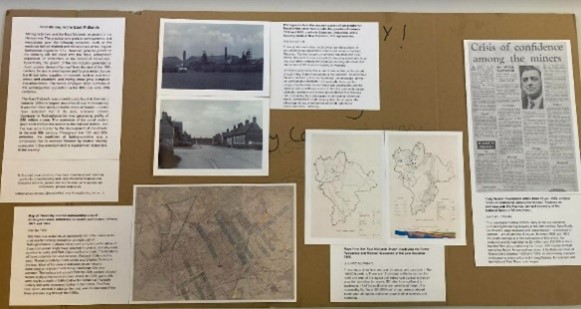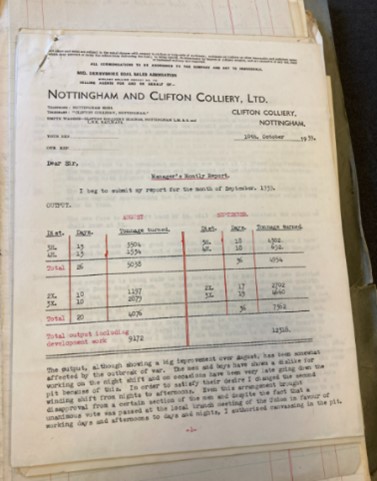
February 5, 2024, by Chloe
Working with the Mining Collections
This is a guest post by Owen Coller, who volunteered at Manuscripts and Special Collections between October and November 2023, as part of the Nottingham Advantage Award scheme.
As a humanities student, the opportunity to explore a collection of 19th and 20th century sources through the Nottingham Advantage Award was both a daunting and exciting opportunity. My placement task at Manuscripts and Special Collections was to create a display for the Business Library, focusing on one of Nottinghamshire’s traditional business sectors. The mining industry and its rich local past stood out as perfect for this. Determined to try and connect the local community in a small way to its history, I set out especially to include the social history of the miners, with the intention of trying to understand their lived experience.
The department’s material catalogue made the initially imposing task of delving into an enormous collection much more straightforward. It was the first step in my role of identifying relevant material to be presented in the display, which was then followed by researching some contextual and factual detail.
My display attempted to touch on as many aspects of mining as possible, from the dramatic political engagement of the National Union of Mineworkers to close-knit communities and those within them, including the work of children forced to miss school to earn a minor wage. It is a complex industry, and the department’s collection contains a huge variety of sources covering a wide range of areas, including newspapers, photographs, maps and financial reports. Official documents, such as from Nottingham and Clifton Colliery, reveal the innerworkings of the mining companies, and at some points the thoughts of influential individuals. Initially the display gave a short overview of the industry in the East Midlands, using maps and diagrams to show the concentrated distribution of coal seams in Nottinghamshire. The East Midlands was the most profitable mining area in the country, and figures from financial records were used to prove that hundreds of thousands of tons of coal were mined every year in just a small area. Some images presented were taken from larger sources and in these cases I tried to discuss them in their entirety, picking out key messages they conveyed; for example, one source is taken from a contemporary booklet about the Miners’ Strike which is useful when read as a whole. I generally provided some interesting contextual background to the images as well.
For the local reader, I kept in mind that many today have familial connections to this recent history and hoped to paint a picture of the hazardous lived experience of the twentieth-century miner and the hours of back-breaking work the role entailed. For example, a workers’ song ‘Fourpence a Day’, preserved in popular culture and media for decades after its composition (and as a result probably the most interesting source I found), reveals an understandable frustration at the working conditions and a definite camaraderie among fellow workers. A focus on sources from the Miner’s Strike of the 1980s, repercussions of which can still be felt in society today, aimed to involve the perspective of women, a reminder that mining life was also the story of families and community and not just tunnels and coal.
Experiencing heritage at MSS has been an insightful and gratifying experience, allowing me to approach and write about history from a unique perspective. Accessing the collections is a flawless process and I encourage the reader to make use of them, whether for academic purposes or personal research. Handling the sources themselves, especially as a student who studies copies and digitised versions most of the time, was a more profound feeling than I was expecting. Delving into authentic stories of the past and presenting them is the kind of meaningful work that heritage is all about. I would like to thank the staff who helped me in this process and who are constantly working to preserve the history of Nottinghamshire, ensuring it lives on.
No comments yet, fill out a comment to be the first


Leave a Reply